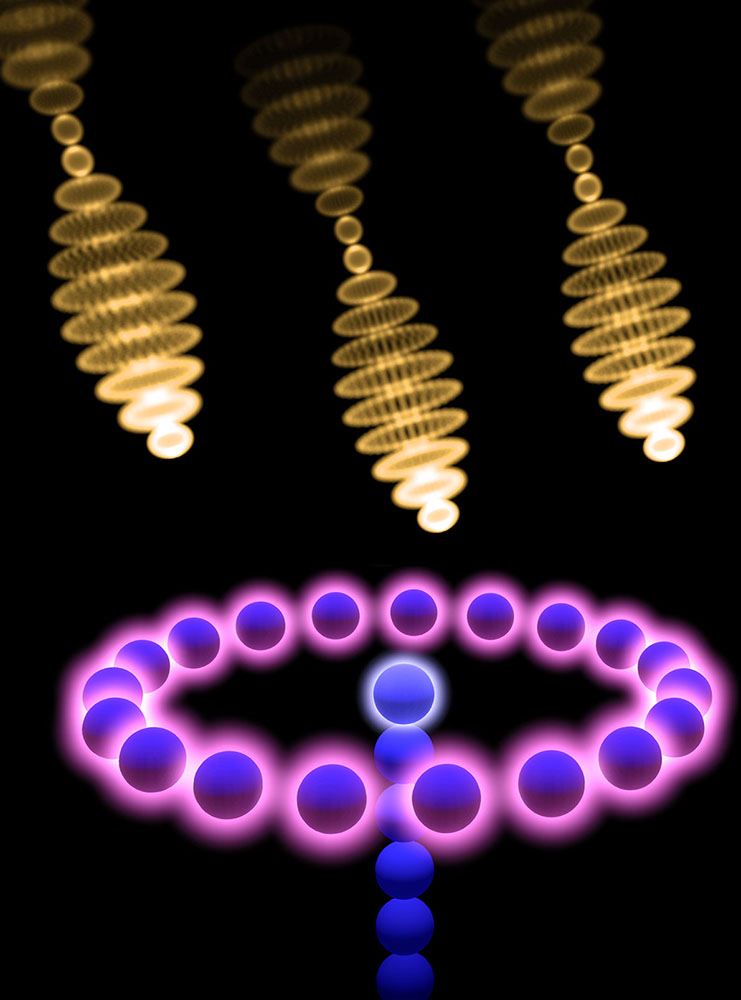Highlights
Superabsorbing ring could make ultrasensitive camera pixel

A ring structure can act as a superabsorber of photons, predict CQT researchers and their collaborators. Image: © 2014 Simon Benjamin CC-BY
A quantum effect in which excited atoms team up to emit an enhanced pulse of light can be turned on its head to create 'superabsorbing' systems, says an international team including researchers from the Centre for Quantum Technologies, National University of Singapore. Their work is published 22 August in Nature Communications.
The team's calculations show that structures such as molecular rings can be engineered to be super-efficient absorbers of light, a property that would make them ideal as sensors in cameras or scientific instruments, for example.
'Superradiance', a phenomenon where a group of atoms charged up with energy act collectively to release a far more intense pulse of light than they would individually, is well-known to physicists. In theory the effect can be reversed to create a device that draws in light ultra-efficiently. Collectively, N atoms could absorb light up to N times faster compared to the sum of their individual absorption.
But there's a problem: the absorption effect is strongest when the atoms are already 50% charged – and then the system would rather release its energy by emitting light than absorb more. "Our idea for harnessing 'superabsorption' is to simply create a bottleneck that blocks the emission," says Erik Gauger.
Erik and Simon Benjamin, CQT alumni, worked on this project while holding joint appointments with CQT and Oxford University.
Charged up
The scheme exploits a property of ring structures: each time a ring absorbs a photon, it becomes receptive to photons of a slightly higher energy. Charging the device is like climbing a ladder whose rungs are increasingly widely spaced.
"Let's say it starts by absorbing red light from the laser," says Kieran, who is doing his PhD with Erik at Oxford University. "Once it is charged to 50% it now wants yellow photons, which are higher energy. And we'd like it to absorb new yellow photons, but NOT to emit the stored red photons." This can be achieved by embedding the device into a 'photonic band-gap' crystal that suppresses red light: it makes it harder for the ring to release its existing energy, so trapping it in the 50% charged state. The final ingredient of the design is a molecular 'wire' that draws off the energy of newly absorbed photons, returning the system to the half-charged state.
Molecular rings such as porphyrins, arrays of quantum dots or collections of cold atoms could be suitable systems to realise the effect, the team write. The superabsorption for any given ring structure would be specific to a particular frequency of light. This could be an advantage for some sensing applications. For others, different ring structures could be combined to give a broad-spectrum absorption.
"I find the work very interesting. It represents a true physics breakthrough. Once superabsorption is realized in many possible systems like quantum dots, this will find diverse applications such as sensors or energy harvesting systems," says Weibo Gao, an experimental researcher working with quantum dots at ETH, Zurich, with whom Erik has discussed the work.
The research team also included scientists Tom Stace and Gerard Milburn from the University of Queensland, Australia, and Brendon Lovett from the University of St Andrews, UK.






